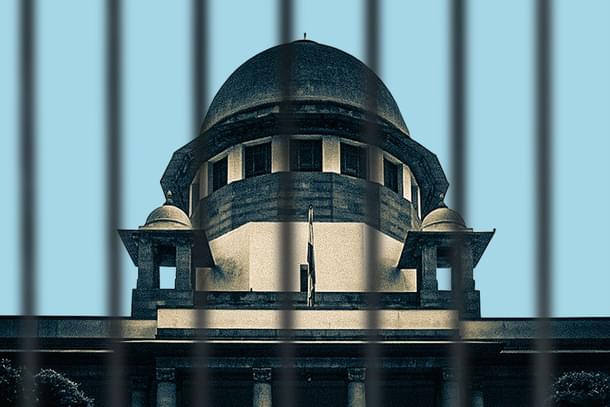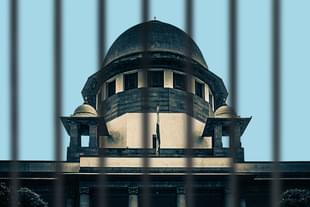Ideas
Explained: How The Collegium System Of Judicial Appointments Came To Be, And The Problems Plaguing It
Rudra
Dec 23, 2022, 05:07 PM | Updated 05:06 PM IST
Save & read from anywhere!
Bookmark stories for easy access on any device or the Swarajya app.


Recently, Law Minister Kiren Rijiju came down heavily on the collegium system of appointment, and said that it is opaque and alien to the tenets of the Constitution.
The collegium system has evolved by way of several enactments and judicial pronouncements.
The procedure of judicial appointments in India is highly diversified as judges of various generations and characters, and governments of different ideologies have tried to impose their rules and systems of appointment to secure ‘judicial independence’, a term often used but not constitutionally explained.
The appointment of judges to the Supreme Court (SC) and high courts (HCs) has been mandated in Article 124(2) and 217(1) of the Constitution respectively.
The provisions provide that the power to appoint the judges vests with the President, “in consultation” with the Chief Justice of India (CJI) for the SC, and “in consultation” with the CJI, the governor of the concerned state and the Chief Justice (CJ) of the concerned HC, for HC appointments.
Previously, the inclusion of the President in “consultation with the CJI” was for namesake and the appointments to the higher judiciary was the prerogative of the executive.
This unfettered power in the hands of the executive was challenged in Union of India v Sankalchand Himmatlal Sheth (1977) where the SC observed that the term “consultation” in Article 222(1) should be interpreted by reading in “real, substantial and effective consultation based on full and proper materials placed before the Chief Justice by the Government”.
Thereafter, several years later, in SP Gupta vs Union of India (1981) (‘First Judges’ Case’) the majority opined that “judicial independence” is a part of the basic structure of the Constitution.
However, it was held that the view of the CJI in appointments and transfers is non-determinative.
Highlighting “executive primacy”, the court held that “consultation” in Article 217(1) does not mean “concurrence”.
It also made clear that the role of the CJI is merely consultative and the final decision vests with the government.
Interestingly, the period during which the executive had primacy over judicial appointments, the higher courts of the country witnessed most competent and impartial judges.
However, subsequently in Supreme Court Advocates-on-Record Association vs Union of India (1993) (‘Second Judges’ Case’), it was ruled that “consultation” in Constitution connotes “concurrence” and held that the CJI has primacy in appointments and transfers, and that his power was held to be “unique, singular and primal”.
Further, it was stated that the opinion of the CJI is not of his own, but of the "collegium", consisting of the CJI and the next two senior judges in line.
The comprehensive working of the collegium was unanimously clarified by the SC in, In Re Presidential Reference (1998) (‘Third Judges’ Case’).
As per this ruling, the collegium would consist of the CJI and four senior judges in line for the SC, and the CJ and two senior judges in line for the HCs.
Now, in 2014, with the Bharatiya Janata Party (BJP) government coming to power, the National Judicial Appointment Commission Act, 2014 (NJAC) was passed.
As per the proposed act, the NJAC would be a six-member group consisting of the CJI, two senior judges in line, the Law Minister and “two eminent persons”, chosen by a committee of the CJI, the Prime Minister and the Leader of Opposition.
However, the constitutionality of NJAC was challenged in Supreme Court Advocates-on-Record Association Vs Union of India.
The majority declared that NJAC is unconstitutional for violating “judicial primacy”, thereby violating the basic structure of the Constitution.
Justice Khehar, in his majority opinion, stated that the power of the executive is not curtailed through the collegium scheme as it can object to the recommendations of the judiciary.
The idea of appointing a commission having only three members from within the judiciary was held to be problematic.
Moreover, it was ruled that disproportionate power was given to the two “eminent persons” as they were empowered to veto the recommendations made by any other member of the commission.
The minority opinion, given by Justice Chelameshwar, is also of significance: distinguishing between the basic feature and the basic structure of the Constitution, he stated that judicial independence is not a part of the basic structure of the Constitution.
The Supreme Court raised serious concerns with the working of the NJAC as it held that “any other suitable criteria” provided in the act reinforced the problems of favouritism and arbitrariness, which in fact are existing in the collegium.
Also, it was pointed by the SC that for any decision to be made, at least five out of the six members had to agree, therefore, the whole system was made prone to disagreements thereby making it redundant and overwhelming judicial independence.
However, considering the balancing mechanism provided by NJAC giving equal say to the executive and the judiciary, if the Supreme Court had concerns it should have required the government for adequately amending the same.
Issues With The Collegium
Not to mention, issues regarding opaqueness, favouritism and nepotism in the collegium’s appointment procedure have been well documented.
Justice A K Sikri has informally stated that while appointing judges to the higher judiciary, “far from the scientific study of candidates we go by our impression”. He pointed out that the collegium system was not working properly and that it needs serious reconsideration.
Moreover, as per a report, around 50 per cent of HC and 33 per cent of SC judges are related to “higher echelons of judiciary”.
Transparency in the selection procedure can only be ascertained by establishing an objective procedure of selection by devising a system that balances judicial independence and accountability.
It is often understood that independence and accountability are unrelated, however accountability is a facet of independence and the faith of the public exists only in an independent institution.
For appointments to the HC, any of the three members of the collegium as per the Third Judges’ Case, may propose a name for the appointment to the bench.
If the collegium collectively agrees that the name of the proposed candidate should move forward based on the “materials available” it recommends him further.
As a matter of fact, these persons are acquainted with the members of the collegium or their colleagues.
Yet many exceptional lawyers who didn’t get acquainted with the members of the collegium may be left out, maybe due to the fact that they never got an opportunity to appear before the collegium members as an advocate.
The Indian judiciary is empowered with the highest amounts of authority but appears to be minimally accountable.
The urgent need for reforms in the appointment procedure can never be disputed, especially since this has become a constant bone of contention between judiciary and the executive.
A perfect balance between independence and accountability can be achieved when the executive has primacy in appointments, but appointments are also based on scientific criteria and not arbitrary considerations, "in consultation" with the judiciary.
In my opinion, the NJAC presented the best way out as the appointments committee was a six-member group consisting of the CJI, two senior judges in line, the Law Minister and “two eminent persons”, chosen by a committee of the CJI, the Prime Minister and the Leader of Opposition.





